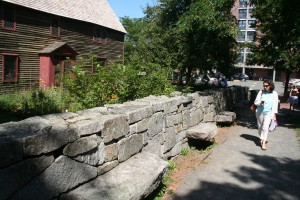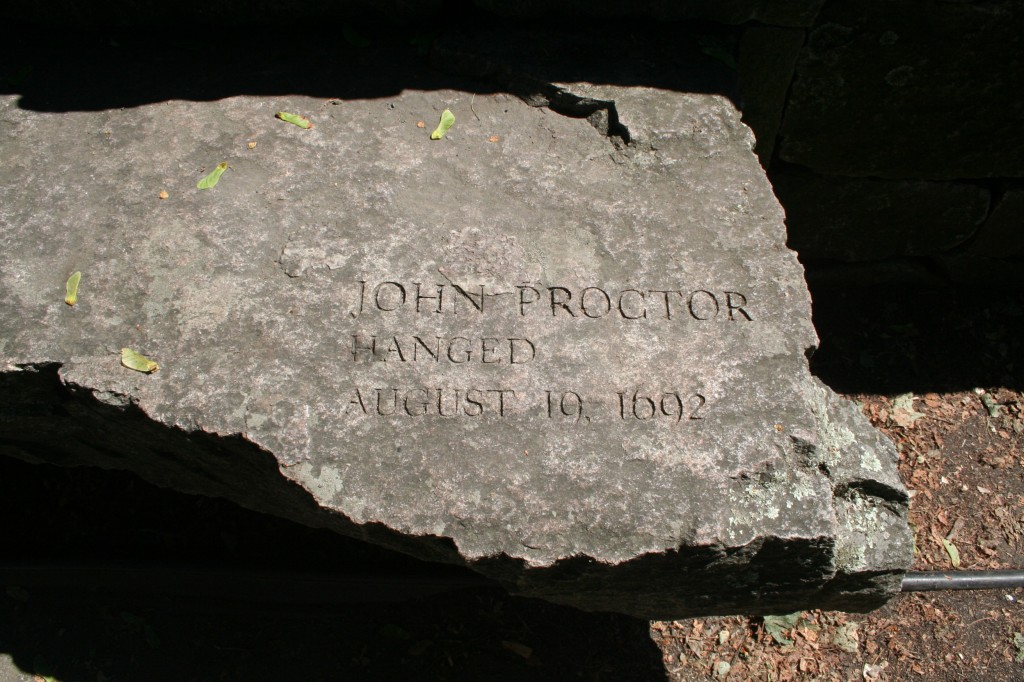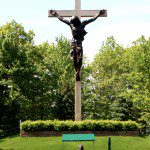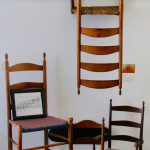
Salem honors the memory of the Witch Trials in a variety of ways. Its most powerful attraction is very simple: the Witch Trials Memorial. Though the monument is located in Salem’s busy downtown area, it nevertheless has a quiet and contemplative atmosphere. Its design was selected from among more than 200 entries in an international competition and was dedicated in 1992 by Nobel laureate Elie Wiesel.
The monument consists of twenty benches that extend from a low stone wall, each inscribed with a victim’s name, date, and method of execution. Chiseled into the entrance to the memorial are some of the victims’ cries of innocence as recorded in the trial transcripts: “I am wholly innocent of such wickedness.” “I am no witch.” “God knows I am innocent.”
Fittingly, the memorial is located next to the historic Charter Street Burial Ground, which contains the graves of many of the townspeople who kept silent while their neighbors were being put on trial and killed.
Several museums detail the story of the trials, including the Salem Witch Museum and the Witch Dungeon Museum. You can also visit the home of Judge Jonathan Corwin, the only structure still standing in Salem with direct ties to the trials.
To me, the most evocative part of my trip to Salem was a performance of Cry Innocent, a play based on the pre-trial examination of accused witch Elizabeth Bishop. Audience members sit in courtroom as actors in period attire move around the room taking on the roles of judge, accusers, neighbors, and victim. It’s an effective technique, making it seem as if one is right in the middle of a witch trial.
I must say that I had some sympathy for the confusion that must have gripped Salem during that time. By the standards of the day, Elizabeth Bishop seemed guilty. Why couldn’t she recite the Lord’s Prayer without stumbling? Surely that could be a sign she was in league with the devil. Why did she scratch the face of her neighbor’s child? Before long I could see how a web could be woven of half-truths, wild accusations, and jealousy.
At the end of the performance the audience voted, just as a jury would, on whether Elizabeth Bishop should stand trial for being a witch. While the majority of the audience voted no, there were a number of people who voted yes, arguing that by the standards of the day, she did indeed merit further investigation as a witch.
As I walked out of the courtroom, I wondered what it would be like to be put on trial by my neighbors. I can see the overwhelming temptations of such a setting, how old grievances could be aired and scores settled. Especially in the precarious world of seventeenth-century Salem, it must have been a great relief to find an answer to the mysteries of failed crops, stillborn babies, and deaths by sudden illness. Then, as now, scapegoats represent the tantalizing hope that by banishing or killing the victims, all that is harmful in a community will disappear.
I feel like I’ve witnessed a witch hunt or two in my day (in a much milder form, but a witch hunt nevertheless). It’s easy to feel morally superior to the seventeenth-century townspeople of Salem until one recalls that human nature hasn’t changed that much in the intervening years.
Dear readers, have you ever experienced a witch hunt?












